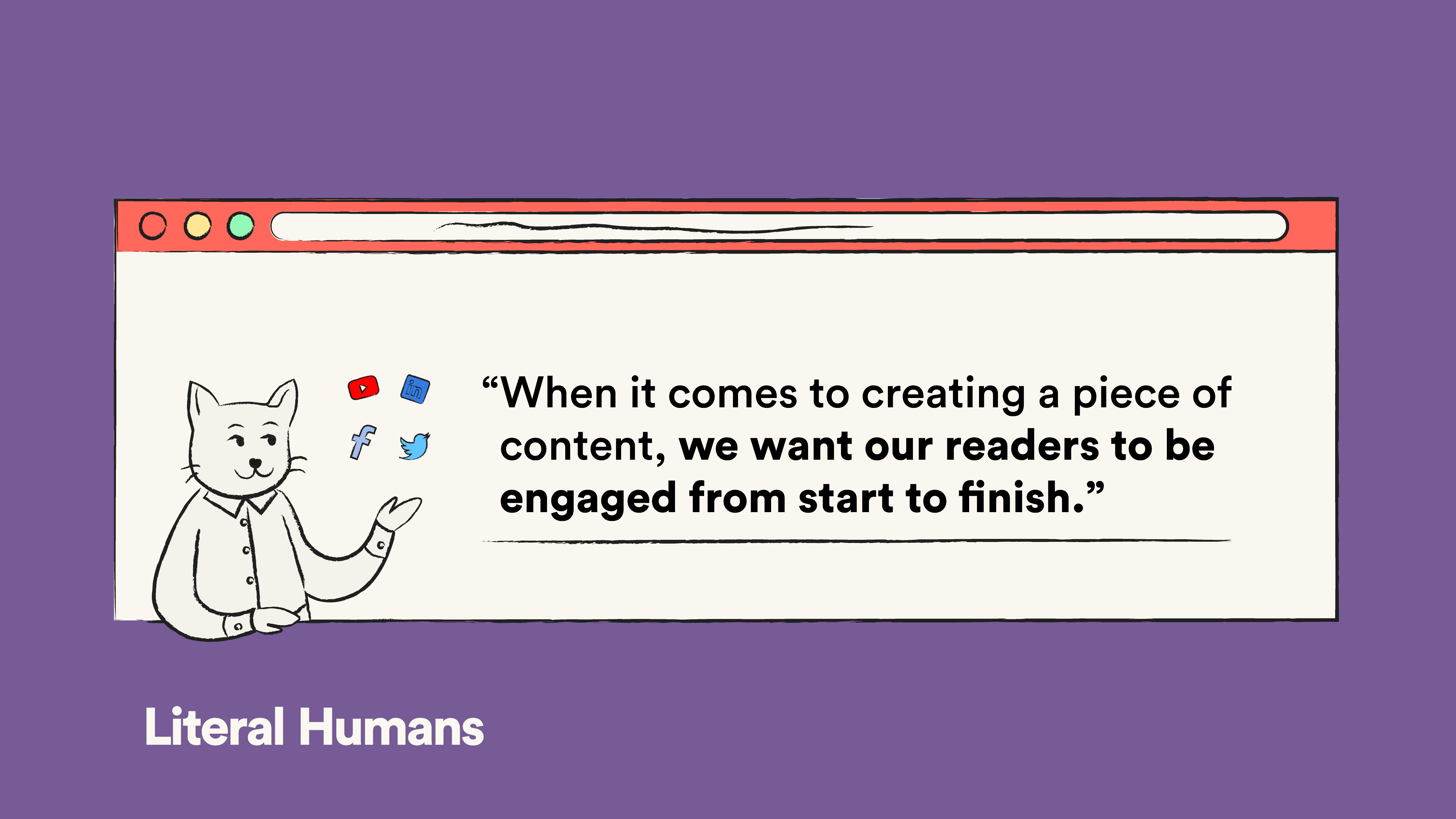Content marketing is a tricky thing to navigate. Whilst you want to deliver as much high-quality content as possible, this can take time. And you don’t want to leave huge gaps between each post, or your audience will become disengaged.
When it comes to the question of quality vs quantity, it can be hard to know which direction you should go in. Of course, the typical advice is that you should try to balance each equally, but this isn’t always feasible.
So, let’s take a look at the key differences between quantity and quality, what you should generally avoid, and how to keep a consistent flow of information across your social media and blog platforms whilst retaining that degree of excellence in what you produce.

Quality vs quantity – what are the differences?
Think of content creation like a tangible object – something that you’d buy in a store. Shoes, for example.
Low quality shoes aren’t as durable, meaning you’ll have to buy a new pair sooner than you’d like, and aren’t made from authentic materials. However, they are inexpensive to manufacture and buy, and a large number of items can be mass produced. High-quality shoes, on the other hand, are carefully crafted and have more time and effort put into their development. Unfortunately, this means they are more expensive and harder to produce on a larger scale.
Here’s a basic breakdown of what we mean when we transpose these ideas onto content creation.
Quality of content creation:
- The ‘grade’ of something – how much value your customer base can get from it. This is subjective.
- In-depth, insightful information that answers questions and provides actionable plans anyone can follow.
- Often written more organically, with better integrated keywords. This can help with search engine optimization.
- Content with better quality is more likely to solidify you in the market as a trusted source of information.
Quantity of content creation:
- A numerical value: how much of something your business has produced. This could be on social media, on your blogs, or in real life. This is objective.
- Often more shallow, shorter answers, but there are a lot more articles to choose from about a subject.
- Some companies turn to AI creation to develop a large quantity of articles, which boosts their online presence faster.
- Having a high volume of articles to post means you can create a schedule back-log. This way, you’ll never be without something to post.
How does this relate to content length?
When it comes to creating a piece of content, we want our readers to be engaged from start to finish. However, this can be a tricky task when we present them with longer articles that are several thousand words long. It’s only natural that people will lose interest at some point – that seems to be the nature of the internet.
So we need to keep our blogs short, snappy, and to the point. We need to deliver correct, accurate information to our target audience without waffling or overcomplicating things.

Here are a few tips on how to adjust your content length so that you can make the most of both quality and quantity in your writing.
- Section with headers. To help section information, make use of a contents box and headers throughout your article. This allows people to skip right to what they need to find, and means they won’t have to scan through the text to pick out relevant bits.
- Use short-form and long-form content. Rather than posting one long piece of text sectioned into headers, consider making a series of two or three posts. These articles will be more digestible, easier to access, and do wonders for your click-through-rate as people will move from one to the other.
- Include infographics where possible. This helps break up the text, and presents bite-sized chunks of information (such as statistics or lists) into a clear, attractive format. These infographics stand out when someone scrolls through, and helps condense down your writing.
- Hyperlinks and internal links. If you’re dealing with niche topics and subjects which require definitions, make use of hyperlinks in your text. These links can lead your readers to where they can find more information about something, without sacrificing on your word-count.
- Experiment with mediums. There are many different types of content, and not everything has to be a blog. Perhaps something you want to display would be better as a video or a post on social media. Making use of a variety of mediums is great for engagement across all platforms. It’s also more accessible in many cases, as people can watch a video or listen to a podcast on the go. Be creative with it!
- Plan out your content. Before you start writing or recording, know exactly what you want to say. Make sure you cut out any useless information that doesn’t add benefit.

What should you avoid?
Fantastic, we’ve got the basics down, and you can begin looking at where your preferences fall when it comes to higher quality or higher quantity. But be wary of some of the pit-falls that content creators face.
Keyword stuffing
The SERP is something every writer wants to be on. And the best way to do that is by strategically using keywords so that Google’s algorithms pick up your content. But it can be tempting to shove random words in willy-nilly when you’re trying to produce a lot of content at once.
Don’t fall victim to keyword stuffing when it comes to creating a high quantity of resources. This dramatically reduces the value of an item, and it reads very strangely when your audience comes across it. If you use AI assistance, always check and double-check what it has produced. Besides, adding that human touch to your work is a far better way to build trust in an audience.
Posting randomly
People like schedules. Businesses like schedules. It’s easier to plan for something when it’s due to arrive or be sent out at a set time each day, week, or month. Before you post your first blog, make sure you have enough content ready that you’ll be able to keep pace with whatever frequency you decide to set. Keep the sustainability of your work in mind.
A weekly or bi-weekly post is a great way to get you started. You don’t want to burn out by posting everything all at once, then drop off the face of the internet and leave your newly emerging audience wondering where you’ve gone.

Created with Canva
Going off topic
It’s nice to know that a business has a well-rounded knowledge of the field it operates in, and how its products and services work. But you need to be careful of spreading yourself too thin, over too wide of a range of topics.
If your blog focuses on travel writing, don’t then start creating content about the housing market back home. There’s no point. All it will do is confuse your readers.
If you really want to start broadening the horizons of your writing, be sure to make this clear to your audience. You’ll also have to spend time researching this new topic to make sure you are knowledgeable in that area, and can keep providing good quality articles.
Getting stuck on perfectionism
This is definitely something you have to learn and experience for yourself on your journey, but nothing’s ever going to be 100% perfect. You’ll always find a tiny thing to do a little better. Eventually, those start adding up. Get rid of the perfectionist mindset or you’ll never post anything!
It’s definitely possible to get hung up on the importance of quality. Learn to let go, do one final check, and then hit ‘post’. Believe us – if you’re that desperate to make it perfect, then your article will immediately be better than 90% of the stuff out on the internet already. So many articles are posted without fact-checking, editing, or care.
Take a deep breath, and don’t stress. You’re doing great.

How to find the perfect balance
Whether you’re a business owner or an independent blogger, you want whatever you create to have a good reception. To do so, you need to accurately balance the quality and quantity of your produce.
For smaller bloggers and businesses, it can be advised to focus more on quantity first. This builds up a quick portfolio of work that gets people interested. Once you’ve started to build an audience and are more confident not only in your industry, but also in your ability to write, then you can start producing more quality items.
If you have a wide selection of posts for your audience to choose from, you can begin to track and analyze which posts they like more. Always keep in mind: what gets you the best engagement? Are people sharing your work on social media? If so, are these for the right or the wrong reasons? It’s always worth keeping an eye on how your brand awareness is doing.
Our most important tip has to be that consistency is key. Planning out a realistic, attainable schedule will allow you to derive greater value from what you put into the world. This is the best way for you to balance the quality of your written content with the quantity of it, and give your readers the best of both worlds.

Final thoughts
Ultimately, how you decide to go about your blogging journey is your decision. But it’s always useful to take yourself away from the situation and view what you’ve written like you’re looking at it for the first time.
Put yourself in the shoes of the reader (sorry, back with the shoe metaphors). Does your piece read well? Is it visually appealing? Are there any bits that make you pause and think, hm… is that right? Is it engaging enough, or insightful enough?
Once you’ve got that sorted, you’ll be well on your way to creating a fantastic blog that you can be proud of. And you’ll hopefully see a steady stream of people coming back to it every time you post something new.










